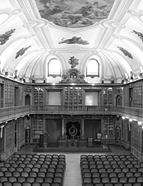

The early 1950s marked the beginning of an era of new historians with Salvador Dias Arnaut (1913-1995) and Fr. Avelino de Jesus da Costa (1908-2000) joining the Faculty in 1952, however, they only completed their PhDs in the late 1960s. The arrival of these two new teachers, who were joined shortly afterwards by João Manuel Bairrão Oleiro (1953) as Chair of Archaeology, coincided with the inauguration of the Faculty's current building on 22 November 1951. However, it would take almost another decade before new directions in historiography in Coimbra were truly consolidated, in line with what was happening in and beyond Portugal in several national areas, embodied in the implementation of the 1957 reform, as mentioned further ahead.
The content of these teachers' lectures, which did not always rigorously correspond to that recorded in the summaries, sheds light on some historiographical trends reflecting national and foreign historical knowledge and, naturally, the teachers' own conceptions, how it was studied over time for some subjects, and occasionally for the action of some of the teachers. Research, which has always been associated with teaching since the foundation of the Faculty, also unveils some of the teaching trends and allows for an assessment of the themes imposed during each period and how they were conceived.
The Faculty of Arts' drive for research is entrenched in the emotion of its beginnings. In fact, the Faculties participated in the republican reform of the University which was generally well-received. According to the regenerative provision of the organic law and the text of the university's constitution, the aim was to establish active teaching in History, whereby practical work and research would be compulsory while lectures would not. What was to be avoided was precisely the simple rhetorical remembrance of notable facts, in order to elevate History to the dignity of a science through the understanding and reconstitution of the past by means of a rigorous critical process (A Faculdade de Letras ao país [Faculty of Arts to the country], 1919, p. 33).
To this end, an «objective, critical, up-to-date and intensive» teaching approach was introduced, as classified by the afore-mentioned text, which involved a search for teaching materials, to the degree possible, stimulating practical work and organising the research centres. The University Archive, the Machado de Castro Museum and later Conmbriga took on the configuration of «laboratories», while the Faculty reserved management of the Archive for itself.
